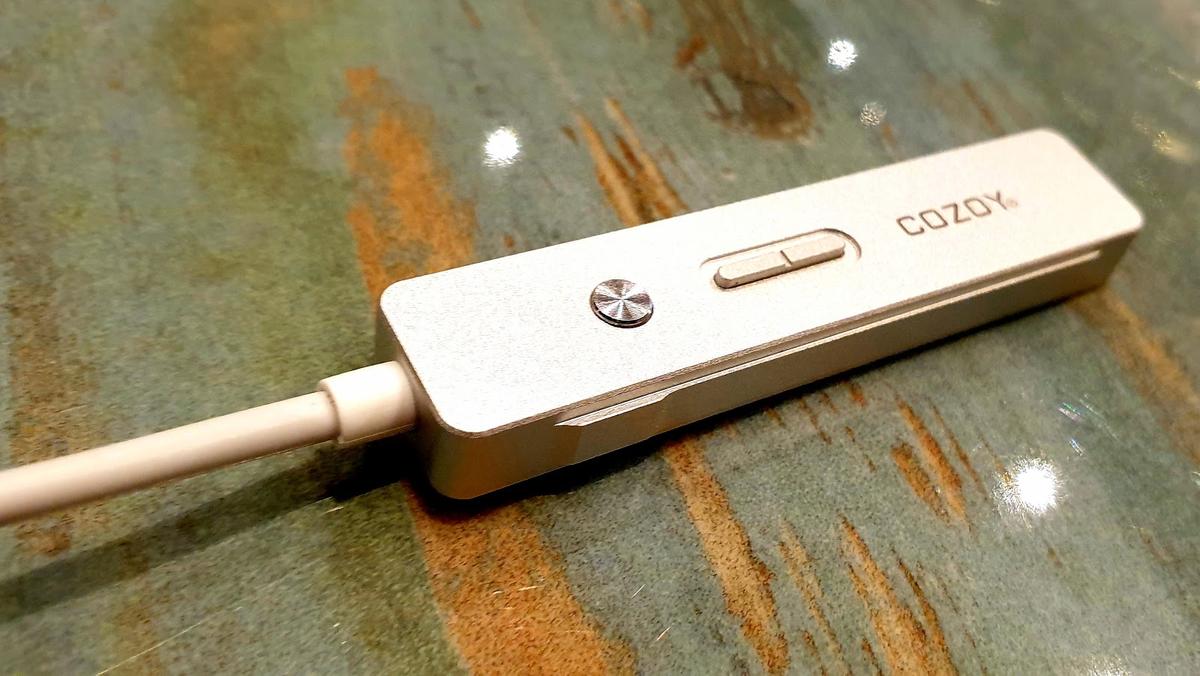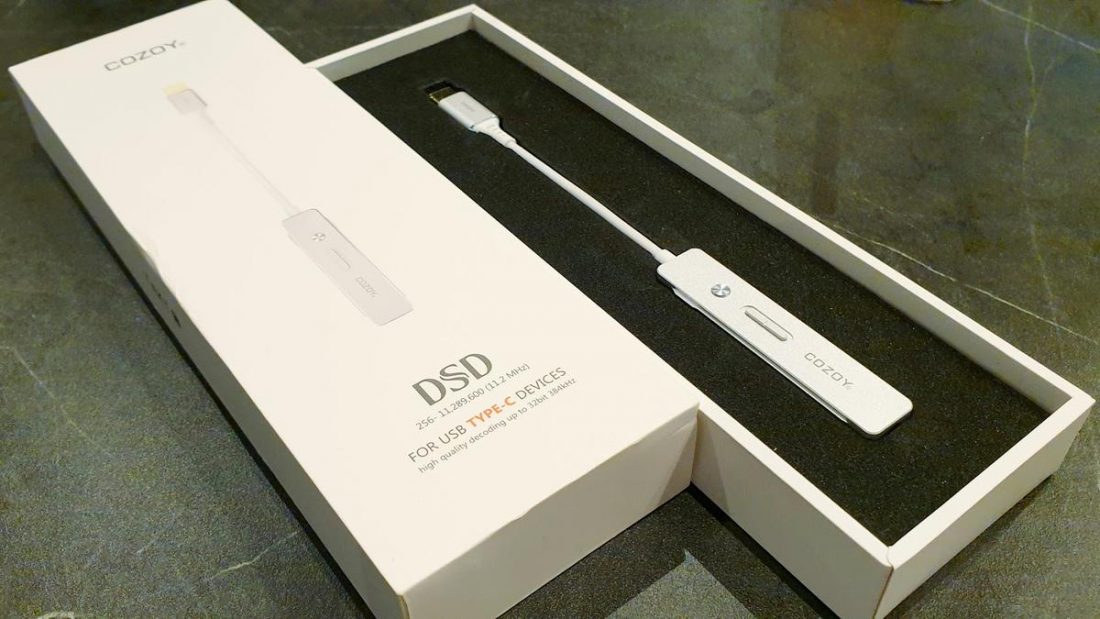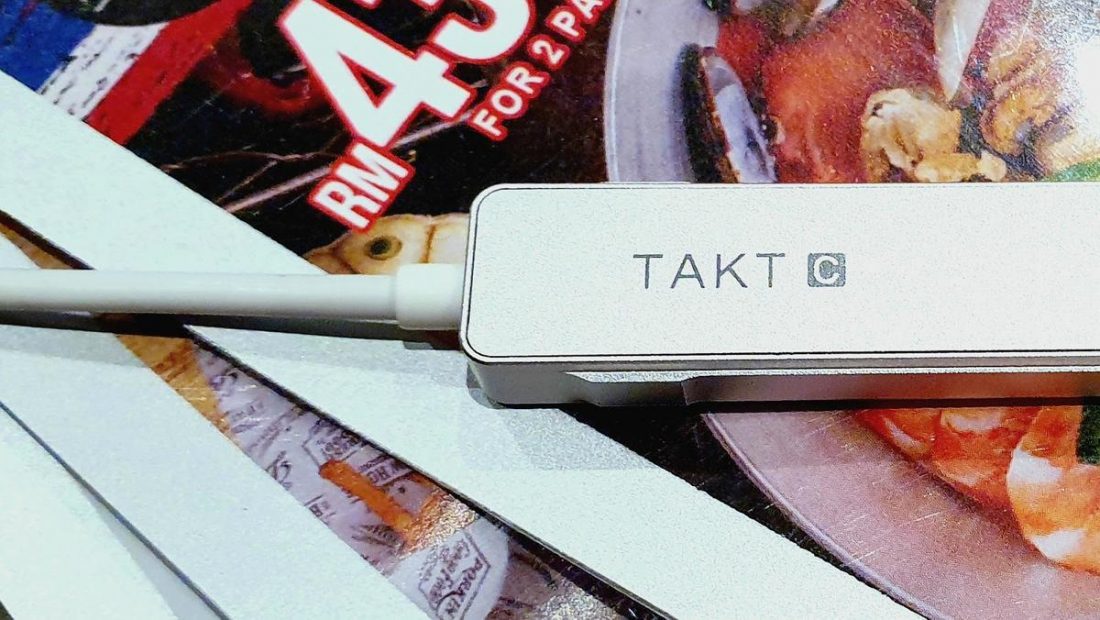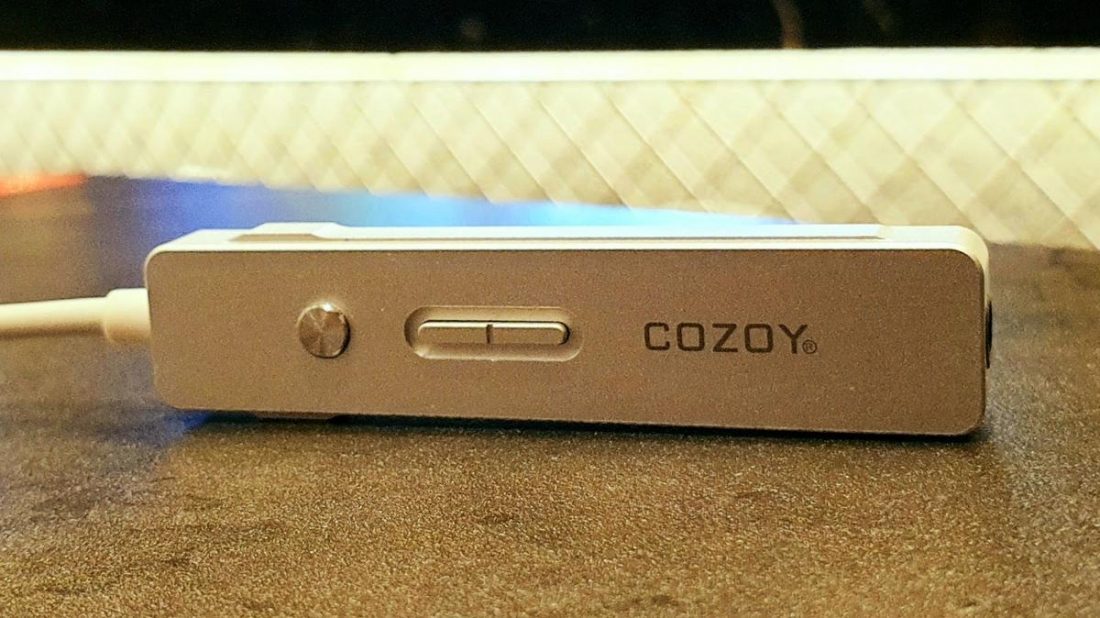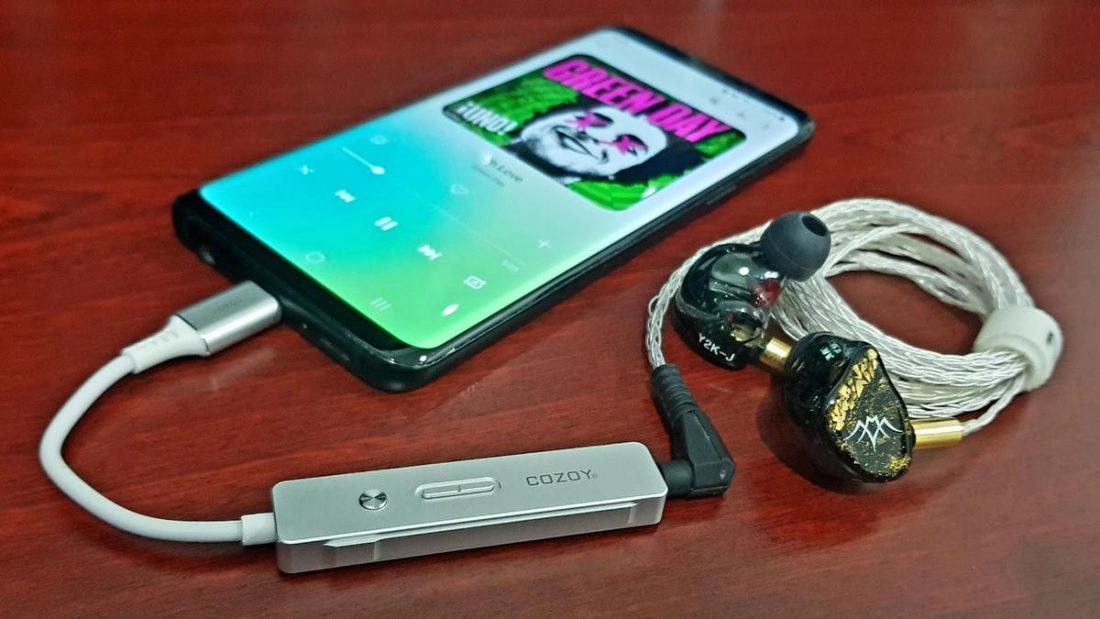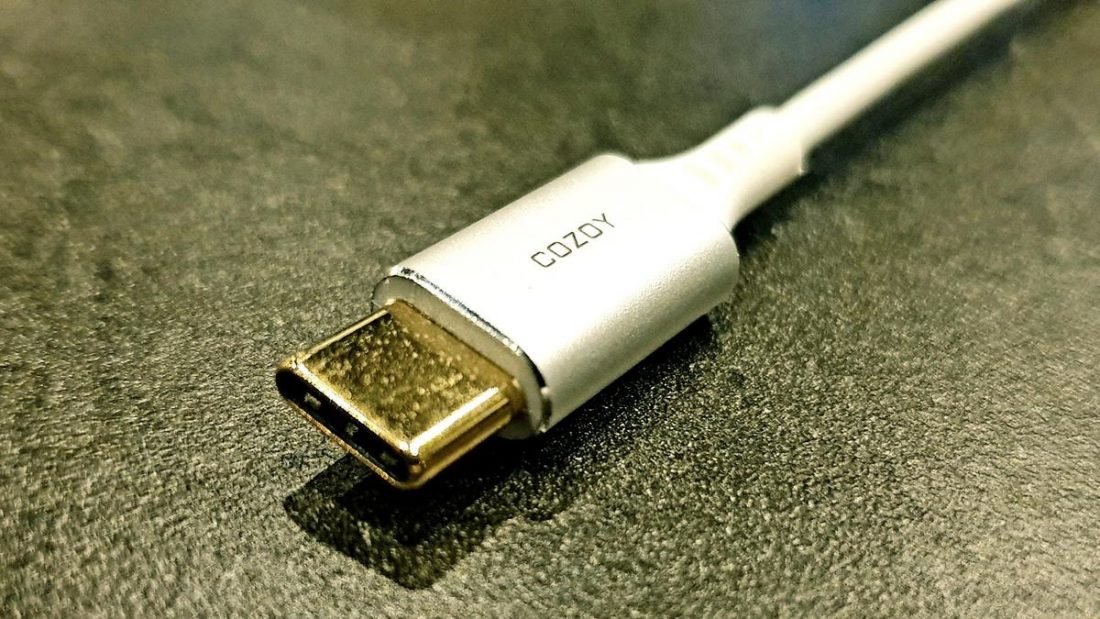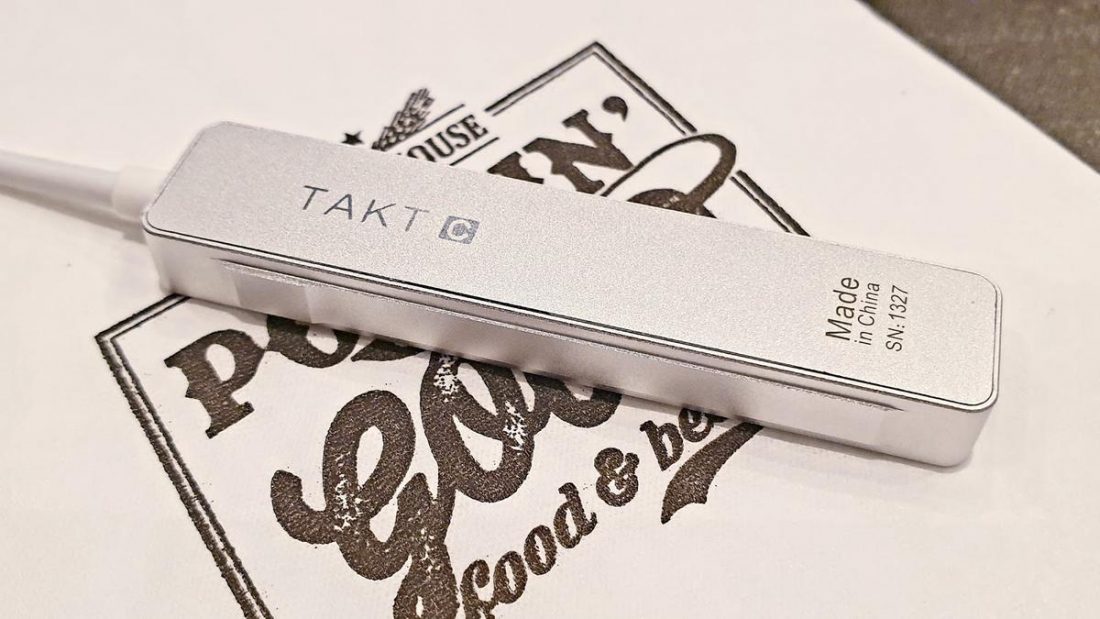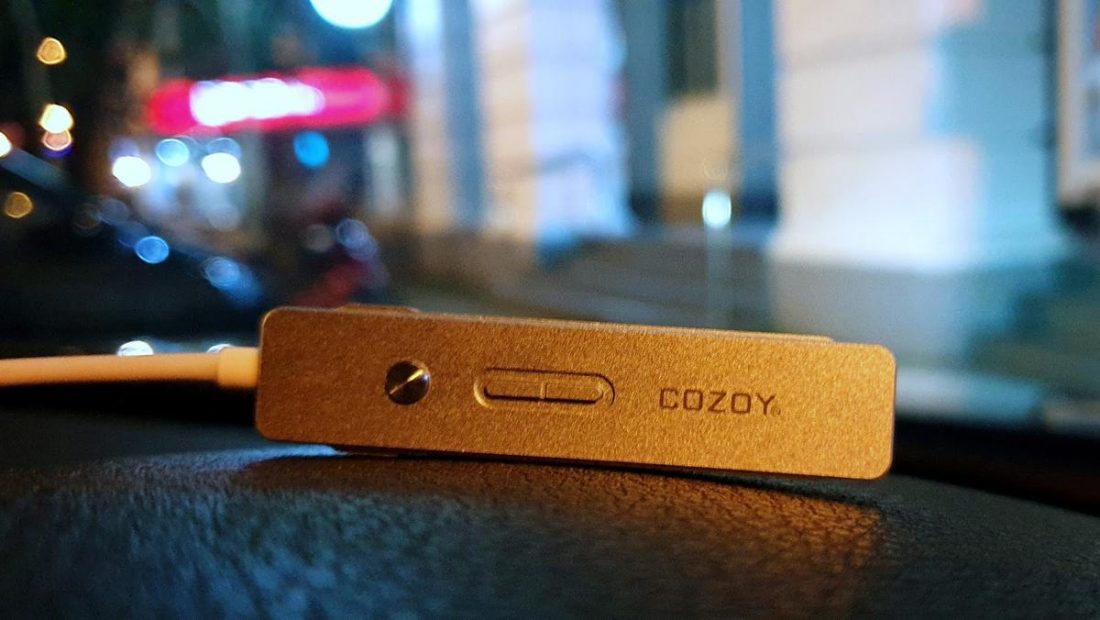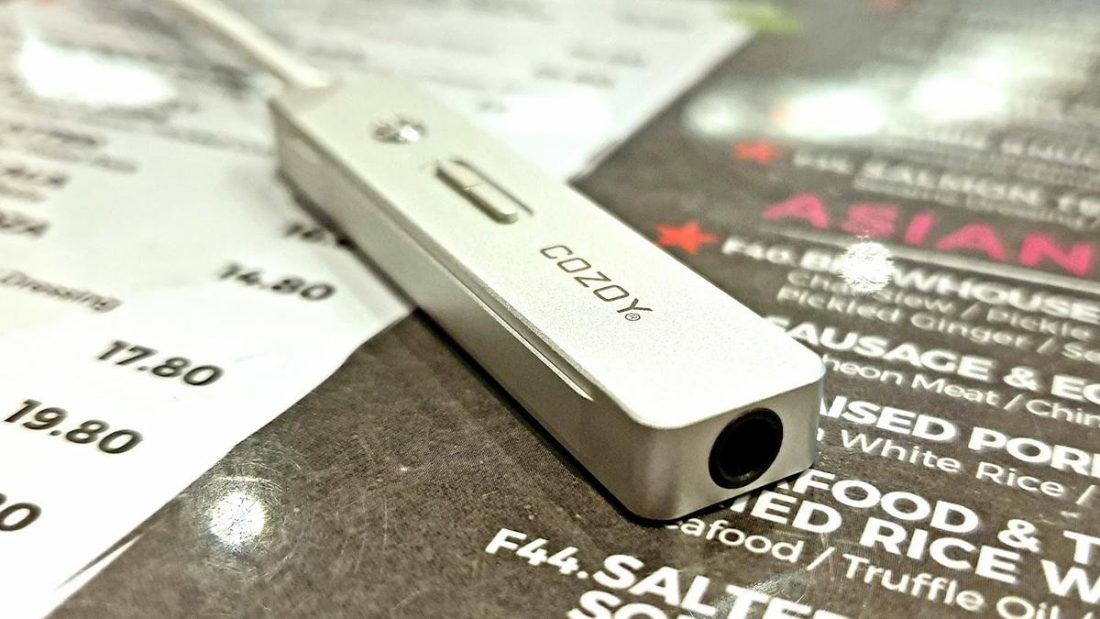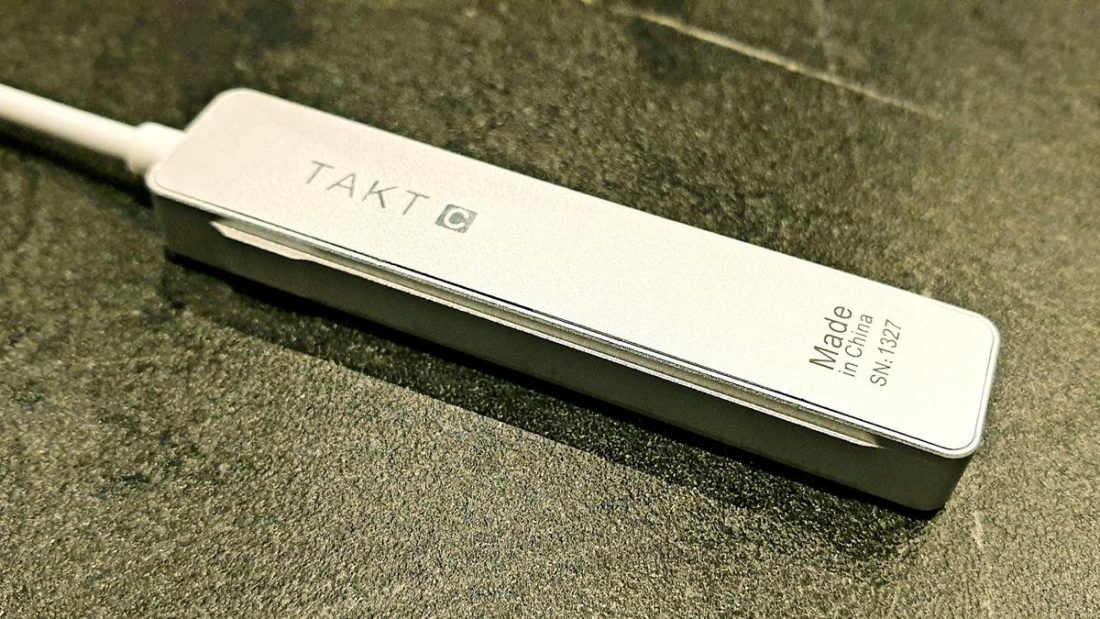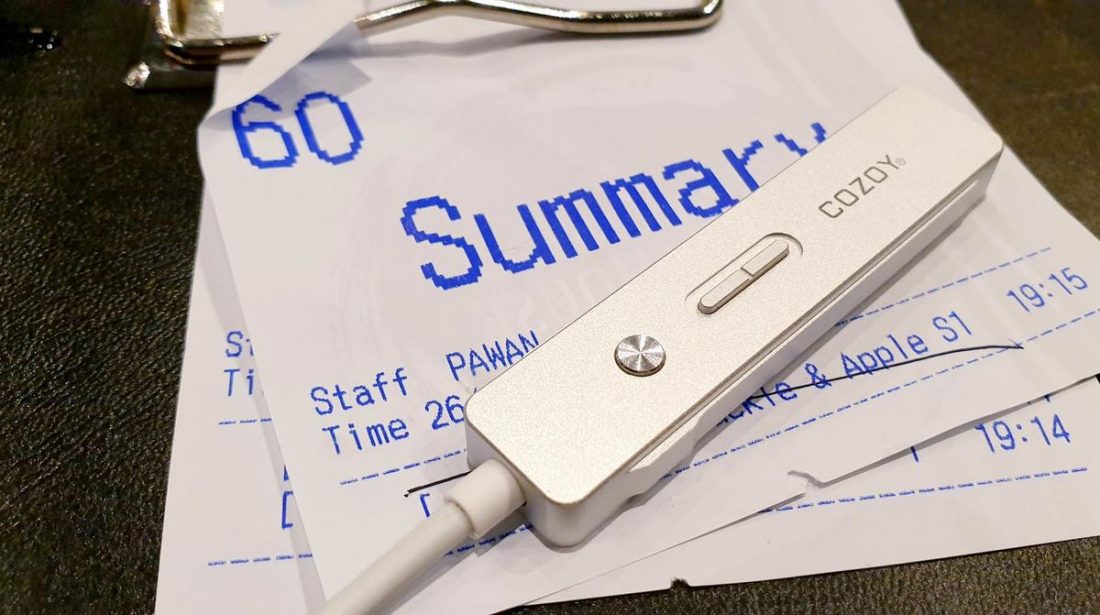Once upon a time in audioland, headphones, IEMs and cellphones lived together in perfect harmony just like the old McCartney/Wonder song. This was thanks to their mutual friend, a demure little opening known as the headphone jack. The partnership was sacred and unquestioned, because how else could you deliver private, personalized audio to the discerning listener? Then came September 7th, 2016 and the unfathomable happened. A certain fruity company deemed the headphone jack surplus to requirements and sent them the way of Nokia and Netscape. It felt like the death of Superman. Or if you’re younger, maybe Tony Stark? To fill the void, wireless headphones and IEMs came into the fray, and so did, less glamorously, dongles.
What the Dong?
Today we look at a dongle by Hong Kong’s Cozoy, the Takt-C (pronounced “taxi”, probably). A pocketable DAC/amplifier the size of your pinky, it connects to cellphones, tablets and laptops via its USB-C connector. Featuring a Sabre DAC by ESS Technology that supports DSD256 and sample rates up to PCM 32bit/384kHz, these buzzwords are sweet music to audiophiles’ ears.
Where To Buy
The Takt-C comes in svelte black or sleek silver, and is currently available through HiFiGo. I would like to thank Nappoler Hu of HiFiGo for reaching out with a review unit, without which this review would not have been possible.
Equipment Used:
Albums Listened:
Technical Specifications:
Audio Chip: Advanced Sabre DAC ES9018Q2C Sample Rate: PCM Decoding up to 32-Bit/384kHz Native DSD Support: up to DSD256-11.2MHz Output Power: 1.5Vrms (28mW) @ 32Ω per channel Housing Material: CNC 6063 Aluminium Alloy Body Input Power: Device dependent Input: USB Type-C Output Port: 3.5mm TRS jack Signal to Noise Ratio: 120dB Cable Length: 10CM
Packaging and Accessories
Look, I know you came here looking for a good time, but Takt-C provides an unboxing experience as simple as the device itself. The Takt-C is housed in a thick, white cardboard box, with a photo of said device printed in front, and main features printed at the back. Open it up, and sitting there comfily in its foam insert, is (ta-daa!) the Takt-C. A user manual printed on a piece of black card completes the unboxing. Does the minimalist, shall we say environmentalist approach and predominantly-white packaging remind you of another, much larger company? One which recently deemed the cellphone charger redundant? Don’t be afraid to draw comparisons, for imitation is the sincerest form of flattery, and Apple fanboys will appreciate the little touches. Probably, I don’t know. My last iDevice was 10 years ago lol.
Design and Build Quality
This sleek stick of steel is agonizingly well-built. It’s not steel? Sorry. Then this altruistic amplifier of aluminium is just a wonder to behold. Takt-C is CNC-machined with aircraft-grade AL6063 aluminium and confers toughness with a hefty side of elegance. The dongle is extremely well-made throughout, from the uniformly smooth, anodized surface to the flush finish, nothing is out of place. In front are the play/pause button, volume rocker, and a smartly engraved Cozoy logo. The buttons are rock-solid, while tactile response is excellent with minimal delay. Despite the robust quality, the dongle is fantastically lightweight and occupies just a tiny footprint. The Takt-C is utterly handsome from all angles, and the screwless design means it’s not one to be scre… I mean messed with.
The Trouble With Fruit
Up top, the dongle leads off to the cable and the gold-plated USB-C connector. The plug’s build and finish are flawless, just that the gold doesn’t match the rest of the dongle’s aesthetics. However, the 10cm off-white cable might be the weakest link of the Takt-C. Eerily reminiscent of Apple cables, I’m not sure the rubber sheath will stand the test of time and toil. I’d much prefer a braided cable instead.
Connectivity
The Takt-C is a plug-and-play device with mind-boggling simplicity (how’s that for an oxymoron). Cozoy did all the number-crunching and hard labor, and the end result is a wonderful device that doesn’t need charging nor installing drivers. All you have to do is connect Takt-C’s USB-C connector to your device, plug your headphones/IEMs into Takt-C’s 3.5mm jack, and start your usual music app.
The Setup
Features and Functions
Sabre ES9018Q2C DAC Chip
Developed by American company ESS Technology, this DAC chip comes with a built-in amplifier. It is capable of decoding sample rates up to PCM 32-bit/384kHz and DSD256. It also implements an ultra-low power consumption design, discarding the need for a separate battery.
Time Domain Jitter Eliminator
Audio jitter is characterized by distortion or irregularities in the audio signal. Exclusive to ESS Technology, Time Domain minimizes jitter coming from the input clock, resulting in a purer signal and hence, improved clarity.
TCXO Crystal Oscillator
This oscillator circuit uses a piezoelectric crystal and temperature regulation to create a stable clock signal with constant frequency. This necessitates a steady, sturdy performance over a wide temperature range, practically producing a crystal-clear sound.
4-Layered Gold-plated PCB
Inside the Takt-C is a rigorously-engineered circuit board that comes in 4 layers to maximize performance from a slim form factor. The gold plating is not just for show, but to improve durability and resistance to oxidation. The more you know.
Usage
Takt-C aims to be your solution for high fidelity audio on-the-go. In my experience, my commuting needs are fulfilled. It’s stupendously easy to connect and plays music in no time. The lightweight, sturdy build is the icing on the cake, and having such a small footprint means I can have the Takt-C in my backpack at all times without making any concessions in space.
Ratted Out
The buck stops with several hindrances during regular use. Firstly, Takt-C’s volume changes too suddenly, especially for sensitive IEMs. One press on the volume rocker can make music either too loud or too soft, because the typical Android phone has just 15 volume steps. To circumvent this you’ll have to increase the steps via a separate volume control or music player app, so Takt-C has more wiggle room. Tedious, but good for your sanity. Also, the Takt-C tends to heat up fairly quickly, and the rise in temperature is obvious if the dongle is in your pocket. This takes the term pocket rocket a little too literally, and mars an otherwise pleasant experience. Last of all, the Takt-C doesn’t come with a color-coded LED to indicate the sampling bit-rate. I took them for granted in my last three portable DAC reviews, so the absence really hit home.
Power Output
The Takt-C ran the gamut with a selected collection of varied transducers.
Dunu Luna, a single DD IEM rated at 16Ω impedance Hidition Violet, an IEM with 11BAs rated at 32.5Ω Fearless Audio x Crinacle Dawn, a hybrid IEM with 6 BAs and 2 electrostatic (EST) drivers, rated at 20Ω Sennheiser HD660S, a DD headphone rated at 150Ω
The Takt-C drove all IEMs flawlessly, with good volume, bass quantity, spaciousness and dynamics, set against a jet-black, hiss-free background. The sound was intricately detailed and immersive, without distortion at high volumes. Job well done. The HD660S though, tells a different story. At a higher impedance rating, it’s a full-sized headphone meant for a desktop system, so I’m just trying my luck with Takt-C. No dice. The bass is sluggish with transients masking one another, while imaging is not as clean and clear-cut. Worse still, there’s distortion at higher volumes, suggesting that Takt-C is an IEM specialist.
Sound Quality
Overall Sound Signature
At first listen, I paused, and checked for errors in connectivity. Cellphone to dongle to IEMs, what could be simpler? Upon further listening I found what was bothering me – the Takt-C had a cunning, uncanny resemblance to my Samsung Galaxy S9’s sound signature. It was neutral-bright, with a penchant for clarity, air and dynamics, often at the expense of tone, timbre and thickness. No matter what I used the Takt-C with, there it was, clear as day. The thin, nimble notes, the take-no-prisoners speed and transient response, the slightly accented midbass and upper mids for fun and excitability… all the hallmarks of my beloved cellphone. Only, with a dedicated DAC in charge, the Takt-C was essentially a turbo-charged Galaxy S9, with steroids to boot.
What Steroids?
Compared to S9, the Takt-C has a darker, more stable background, better note definition and texture, and more appreciable dynamics across the spectrum. I appreciated the Takt-C for what it was, a direct, transparent gateway to your music rendered as clean and true-to-source as possible, like a shower of crystals.
Listening Conditions
The Takt-C was burnt-in for 50 hours before serious listening, because I don’t trust the Apple-esque cable. The main setup for review is Galaxy S9 > Takt-C > transducer of choice, but mostly IEMs.
Bass
Takt-C’s bass is a story of haste and grace, like Thor in a tutu. Sub-bass extension is seabed-deep with good rumble, yet never overwhelms. When needed, the bass punch is as thunderous (heh) as they come, aided by an ever-so-slight accent in the midbass. Notes are full-bodied, but after the impact, they round off in a graceful yet swift decay, leaving an immaculate background. The bass is the best-balanced in the spectrum, with an organic fullness going toe-to-toe with the electric (heh) clarity. Takt-C takes painstaking efforts to render every fibre of bass detail so you never miss out. Layering and definition are superb, as are the dynamics, the hallmarks of technical mastery. Sometimes the texture is caught out for dryness especially at the upper bass, due to its eagerness in extracting detail.
Mids
Like rows of glistening, neatly-arranged kernels on an ear of corn, Takt-C renders mids with a-maize-ing detail. Don’t kill me. The focus of the sound signature is the mids, demanding your attention with eye-popping clarity and meticulous texture. From the lower to center mids, they are as perfectly neutral and uncolored as they come, with precisely-defined attack and decay, navigating complex passages with gleeful aplomb.
Corny Jokes Aside
The upper mids, meanwhile, are slightly emphasized, giving female vocals a touch of forwardness and instruments a clarity boost (as if regular clarity wasn’t enough). Throughout the mids, transient response, articulation and airiness leave nothing to be desired. However, the tone is a separate matter altogether. The pursuit of technical excellence has left timbre and tonality in their wake. Notes seem dry and overly-textured like having too much fiber in one day. Vocals, especially male, are throaty and lack emotion. Towards the upper mids, the tone drifts toward the cold and brittle, like Ebenezer Scrooge before his brush with the supernatural. A bit of warmth (and maybe some Christmas spirit?) would have made all the difference.
Treble
From here we go sublime. Takt-C’s treble ascends to lofty heights, building on the upper mids rise and extending expertly. Lending a waft of crispy, airy, uh, air, the treble is absolutely transparent with an emphasis on (what else?) detail, oh holy grail of boundless detail. Notes are immensely clear from start to finish, with well-defined borders and a quick, fluttery decay. The brilliant sparkle is addictive, as is the ringing clarity. The clinical incisiveness is a testament to Takt-C’s remarkable technical ability. However, again, the Takt-C won’t do any favors in terms of smoothness nor tonal accuracy. The notes are thin and skewed bright. So while the brightness is no doubt invigorating, the treble texture has a raspy grain to it, taking a notch or two away from absolute enjoyment.
Soundstage and Imaging
Like the petite-sized Takt-C, the soundstage isn’t what you’d call full meal. The dimensions are average, with width, depth and height just hovering at the margins of the head. This lends immediacy and urgency to tracks that are sometimes too close for comfort. Of course, you could artificially increase the soundstage by lowering the volume, but that’s not how we roll. Fear not though, because Takt-C’s saving grace is the brilliant scalpel-like imaging accuracy. The lusciously dark background and quick, incisive notes contribute to the exactness in positioning of instruments and voices.
Comparisons
Radsone EarStudio HUD100
For a few dollars more, you could afford the HUD100, now in its second iteration. The original is already a stellar product with the same function as the Takt-C, and addresses some of the latter’s shortcomings. The USB cable is replaceable, for one, so you don’t have to worry about Takt-C’s cable fragility in the long run. The HUD100 also runs cooler, and has an LED indicator that tells you the track’s sampling rate, something I love.
Clint Beastwood
The driving power of the HUD100 is significantly better, capable of handling my Sennheiser HD660S with finesse, authority, and no audible distortion compared to the Takt-C. And perhaps most vitally, the sound signature boasts some levels of refinement, imbuing a sense of musicality and smoothness despite being equally as detailed as the Takt-C. HUD100 sounds more relaxed and mature than Takt-C, besides being more tonally accurate and spacious. Anakin to your Vader if you will. For laptop use, HUD100 gets an easy, head-and-shoulders recommendation above the Cozoy. However, for cellphone and tablet use, Takt-C is miles ahead in portability because of its slim profile, not to mention HUD100 needs an additional adapter for USB-C connections.
Final Words
One fine day, wireless headphones and IEMs will finally catch up in sound quality. And when that day arrives, wired transducers will approach their twilight knowing they’ve served their purpose for generations. But until then, like a defiant rendition of Paramore’s The Only Exception, dongles will continue to exist and serve a specific niche, supporting cellphones without headphone jacks. Make no mistake, Cozoy’s Takt-C is very worthy of your consideration, combining plug-and-play user-friendliness and a detailed, dynamic sound signature in a slim, lightweight form factor. It also happens to be built like a tank, which is good news for gadget abusers like me. A few niggles prevent them from achieving true greatness, but for what it’s worth, Takt-C is a reliable companion for when you crave portable, pocketable fidelity.
